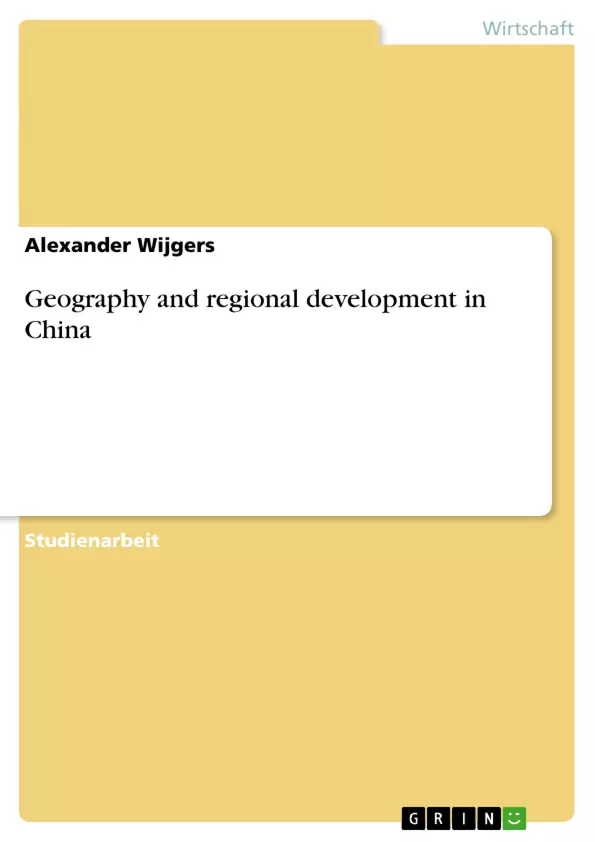The economic growth of China impresses the world; and some country fear about this, because firms displace there production from these countries to china. But China is only the last step in an array of development countries from East / Southeast Asian region. After the fast development of Japan after World War II, the so called tiger countries , South Korea, Hong Kong, Singapore, Taiwan, highlight from the 60s on with high rates of economic growth and later the second generation of tiger countries also (e.g. Malaysia, Indonesian and Thailand). And now China!
A country of 9.5 Million square mile can’t growth on whole with the same rate. The effect is an increase in the disparity of regional incomes and still increase with the boost at the rates of economic growth. But what are the reasons for the regional differences in economic growth and the regional disparity. One reason could be the preferential policies in the eastern regions. These policies are specially prepared to attract foreign companies. A second reason, that is current discuss in the scientific world, could the geographical characteristics. The differences in the distance to the coast or navigable river, the climate or the slope could explain variable development.
This paper wants to illuminate especially the second reason as a possible answer for unequal regional development and regional disparity, but policy and geography are often the same. So it is important to show the link between these possible reasons and the policies with regional impacts. There are different publications about the geographical implication on economic growth in china in the last years, based on different models. The intention is to compare these papers and highlight the differences.
The first chapter handles the historical economic development of the last years in china and wants to show the actual situation. The development especially in policy terms, the change to a market-orientated economy, could already explain many disparities. The third chapter illuminate the regional inequality in China, there development, the theories of convergence and want to give a first answer for the different growth rates. Then we will look to the geography and their effects to Chinese growth rates and at least we make an outlook on future development base on polarization theory.
Inhaltsverzeichnis
- Introduction
- Conditions and Indicator
- National Parameters
- Under Mao
- After Mao
- Distribution of investments
- National Parameters
- Regional inequality
- Theoretical Models of Convergence
- Development of inequality in China
- Reasons of growth
- Geographic Influence
- Geographic factors
- Geographical model
- Future Trends
Zielsetzung und Themenschwerpunkte
Dieser Text beleuchtet die Ungleichheiten der regionalen Entwicklung in China. Er analysiert die historischen und geografischen Ursachen für diese Ungleichheit und untersucht die Auswirkungen von Politik und Geographie auf die wirtschaftliche Entwicklung in China. Das Ziel ist es, ein besseres Verständnis für die komplexen Zusammenhänge von Wirtschaftswachstum und Regionalentwicklung in China zu gewinnen.
- Historische Entwicklung der regionalen Wirtschaft in China
- Einfluss von Politik und Geographie auf die regionale Entwicklung
- Theoretische Modelle zur Erklärung von Konvergenz und Divergenz
- Analyse der regionalen Ungleichheiten in China
- Zukünftige Entwicklungstrends und mögliche Auswirkungen
Zusammenfassung der Kapitel
- Introduction: Diese Einleitung präsentiert das Thema des Textes und die Gründe für die regionalen Unterschiede im Wirtschaftswachstum in China. Es wird auf die historische Entwicklung des Landes eingegangen, einschließlich der Phase des schnellen Wirtschaftswachstums nach dem Zweiten Weltkrieg und der Herausforderungen, die mit dem rasanten Wachstum verbunden sind.
- Conditions and Indicator: Dieses Kapitel untersucht die Entwicklung der chinesischen Wirtschaft im Kontext nationaler Parameter und der Verteilung von Investitionen. Es werden die politischen Veränderungen beleuchtet, die zur Umwandlung in eine marktwirtschaftliche Orientierung geführt haben, sowie deren Auswirkungen auf die regionale Entwicklung. Besondere Aufmerksamkeit wird den Entwicklungen unter Mao Zedong und nach seiner Zeit gewidmet.
- Regional inequality: Dieses Kapitel analysiert die regionale Ungleichheit in China und untersucht verschiedene theoretische Modelle der Konvergenz. Es wird die Entwicklung der Ungleichheit im Laufe der Zeit untersucht und es werden die Ursachen für unterschiedliche Wachstumsraten in verschiedenen Regionen des Landes beleuchtet.
- Geographic Influence: Dieses Kapitel untersucht den Einfluss der Geographie auf die regionale Entwicklung in China. Es werden geografische Faktoren wie die Entfernung zur Küste, die Nähe zu schiffbaren Flüssen und die topografischen Bedingungen betrachtet, die einen Einfluss auf die wirtschaftliche Entwicklung haben können. Es werden auch verschiedene geografische Modelle vorgestellt, die die räumlichen Unterschiede im Wirtschaftswachstum erklären können.
Schlüsselwörter
Die Schlüsselwörter dieses Textes umfassen: Regionalentwicklung, Wirtschaftswachstum, China, Ungleichheit, Konvergenz, Geographie, Politik, Investitionen, Industrie, Entwicklungstheorie.
- Citar trabajo
- Alexander Wijgers (Autor), 2005, Geography and regional development in China, Múnich, GRIN Verlag, https://www.grin.com/document/89506



